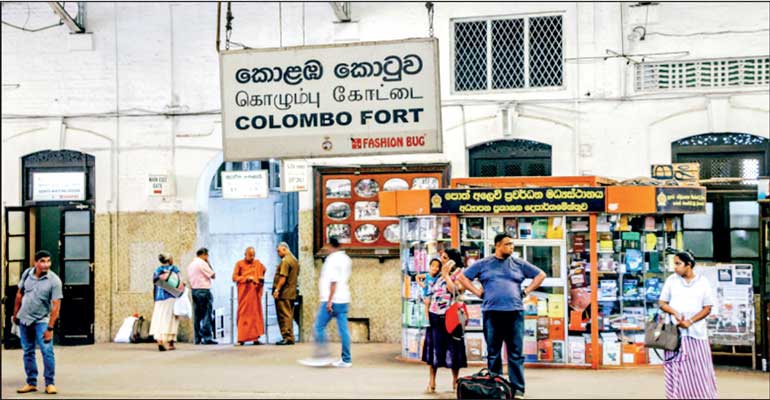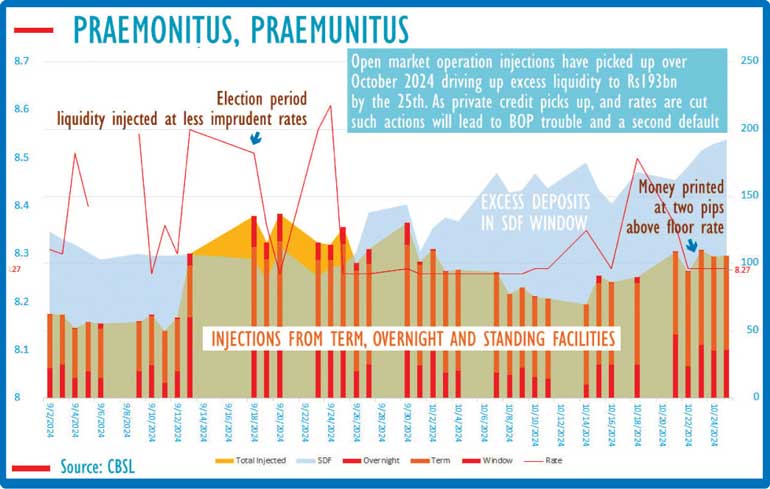Sunday Dec 28, 2025
Sunday Dec 28, 2025
Wednesday, 30 October 2024 00:24 - - {{hitsCtrl.values.hits}}

A sustainable debt strategy rooted in transparency and collaboration with international stakeholders is essential to restore economic confidence and secure a brighter future for Sri Lanka

 Sri Lanka’s debt burden has been a persistent challenge, driving the country into numerous fiscal crises over the past few decades, including the 2022 crisis that brought the country to bankruptcy. The country’s high levels of external and domestic debt have been exacerbated by political mismanagement, economic shocks, COVID pandemic, and global financial pressures. The recent crisis underscores the need for a comprehensive debt sustainability strategy, particularly with a new President in place. Several key options could help Sri Lanka better manage its debt, support long-term economic stability, reduce money printing and regain investor confidence to attract top FDI.
Sri Lanka’s debt burden has been a persistent challenge, driving the country into numerous fiscal crises over the past few decades, including the 2022 crisis that brought the country to bankruptcy. The country’s high levels of external and domestic debt have been exacerbated by political mismanagement, economic shocks, COVID pandemic, and global financial pressures. The recent crisis underscores the need for a comprehensive debt sustainability strategy, particularly with a new President in place. Several key options could help Sri Lanka better manage its debt, support long-term economic stability, reduce money printing and regain investor confidence to attract top FDI.
From ECONOMYNEXT
1. Debt restructuring
One of the most immediate options for Sri Lanka is to negotiate restructuring its external debt, as it has done with creditors like the International Monetary Fund (IMF) and bilateral lenders such as China and India. By extending repayment periods, reducing interest rates, or agreeing on partial debt forgiveness, the country can create fiscal space to prioritise essential public services and rebuild its economy (Jiang, 2022).
Successful debt restructuring requires a delicate balance of diplomacy, financial negotiations, and adherence to structural reforms. Transparent and inclusive negotiations with all creditors will help ensure terms that do not undermine Sri Lanka’s long-term economic growth (Nicholas and Nicholas, 2023).
2. Diversifying sources of borrowing
Heavy reliance on foreign borrowing through sovereign bonds has exposed Sri Lanka to ridiculous high interest rates and currency depreciation risks. A shift toward multilateral and concessional loans could ease the repayment burden. Loans from institutions like the World Bank or the Asian Development Bank that offer lower interest rates and longer repayment periods, making for more manageable debt obligations (Weerakoon and Jayasuriya, 2019).
However, such loans often require stringent reforms and alignment with long-term development goals, making the process slower. Nevertheless, balancing bond issuances with multilateral loans can stabilise the country’s debt profile.
3. Strengthening public debt management
A robust public debt management framework would help Sri Lanka better assess and control its borrowing. Improving the institutional capacity of the Public Debt Department to forecast debt levels, track repayment schedules, and identify risks associated with borrowing is critical (Choudhary, 2022).
Introducing transparent fiscal rules, such as debt ceilings or expenditure constraints, could prevent unsustainable debt accumulation, while an independent debt review committee could further boost public accountability (Rathnasiri and Soysa, 2020).
4. Promoting economic growth
Debt sustainability is closely tied to economic growth. Policies that enhance GDP growth can reduce the debt-to-GDP ratio over time. Investment in sectors like tourism, IT services, and manufacturing, alongside creating a conducive business environment for foreign direct investment (FDI), are essential steps (Waghmode, 2022).
5. Improving tax revenue collection
Sri Lanka’s tax-to-GDP ratio remains one of the lowest in the region, signalling inefficiencies in revenue collection. Enhancing tax administration and broadening the tax base can provide a sustainable source of government funding. Strategies may include taxing the informal economy, improving corporate tax collection, and reducing exemptions that mainly benefit the wealthy (Choudhary, 2022). Addressing tax evasion and closing loopholes would help build a more resilient fiscal framework, allowing the government to reduce reliance on borrowing and focus on long-term development projects.
6. Privatisation of State-Owned Enterprises (SOEs)
Large state-owned enterprises (SOEs) like Sri Lankan Airlines and the Ceylon Petroleum Corporation have been a significant drain on the national budget. Reforming or privatising or PPPs underperforming SOEs could generate revenue and reduce fiscal burdens (Zhang et al., 2022). Partial privatisation or public-private partnerships could ensure better management, increased efficiency, and reduced dependence on government subsidies.
7. Leveraging debt-for-climate swaps
Debt-for-climate swaps offer a novel approach to reducing Sri Lanka’s debt burden while supporting environmental goals. In this arrangement, creditors agree to reduce or cancel a portion of a country’s debt in exchange for commitments to invest in climate resilience or conservation projects (Manullang, 2022). With Sri Lanka’s vulnerability to climate change, this could provide both fiscal and environmental benefits.
8. Adopting a debt anchor policy
Finally, implementing a debt anchor policy that limits government debt to a certain percentage of GDP provides a clear target for debt sustainability. Such policies act as checks on fiscal profligacy, with legislation to formalise these targets demonstrating fiscal responsibility to investors and reassuring the public (Rathnasiri and Soysa, 2020).
Conclusion
Sri Lanka’s debt management strategy must be multifaceted, combining short-term measures like debt restructuring with long-term reforms in revenue collection, economic growth, and efficient public spending. Leveraging innovative tools such as debt-for-climate swaps and SOE privatisation could provide immediate relief while establishing a foundation for future stability. A sustainable debt strategy rooted in transparency and collaboration with international stakeholders is essential to restore economic confidence and secure a brighter future for Sri Lanka.
Resources:
1. Choudhary, S., 2022. Debt analysis of Sri Lanka: Factors and finances. EPRA International Journal of Economic Growth and Environmental Issues. Available at: https://www.semanticscholar.org/paper/DEBT-ANALYSIS-OF-SRI-LANKA%3A-FACTORS-AND-FINANCES-Choudhary/abfc6ff27b6a692246c2ee5bdc438122a65dccfd?utm_source=consensus
2. Jiang, Q., 2022. Debt crisis and national bankruptcy: Evidence from Sri Lanka. BCP Business & Management. Available at: https://bcpublication.org/index.php/BM/article/view/2288
3. Manullang, A., 2022. Food security in shambles: An impact from Sri Lanka national economic crisis. HAPSc Policy Briefs Series. Available at: https://link.springer.com/chapter/10.1007/978-981-13-1864-1_6
4. Nicholas, H. and Nicholas, B., 2023. An alternative view of Sri Lanka’s debt crisis. Development and Change. Available at: https://onlinelibrary.wiley.com/doi/10.1111/dech.12794
5. Rathnasiri, R.A. and Soysa, J.S.V.N.T., 2020. Dynamics of public debt sustainability and economic growth: The case of Sri Lanka. Applied Economics & Business. Available at: https://aeb.sljol.info/articles/10.4038/aeb.v4i1.46
6. Waghmode, P.S., 2022. Investigative study of economic crisis in Sri Lanka. International Journal for Research in Applied Science and Engineering Technology. Available at: https://www.ijraset.com/best-journal/investigative-study-of-economic-crisis-in-sri-lanka
7. Weerakoon, D. and Jayasuriya, S., 2019. Debt financing for development: The Sri Lankan experience. Managing Domestic and International Challenges and Opportunities in Post-conflict Development. Available at: https://link.springer.com/chapter/10.1007/978-981-13-1864-1_6
8. Zhang, T., Cheng, S. and Luo, A., 2022. The last resorts to destroy the democratic socialist republic of Sri Lanka. Frontiers in Business, Economics and Management. Available at: http://drpress.org/ojs/index.php/fbem/article/view/1916
9. https://www.ft.lk/w-a-wijewardena-columns/Child-s-guide-to-critics-of-IMF-s-Debt-Sustainability-Analysis/885-768470b
(The writer teaches accounting and finance at the University of Buckingham, UK and is a researcher on public debt reporting in developing countries.)